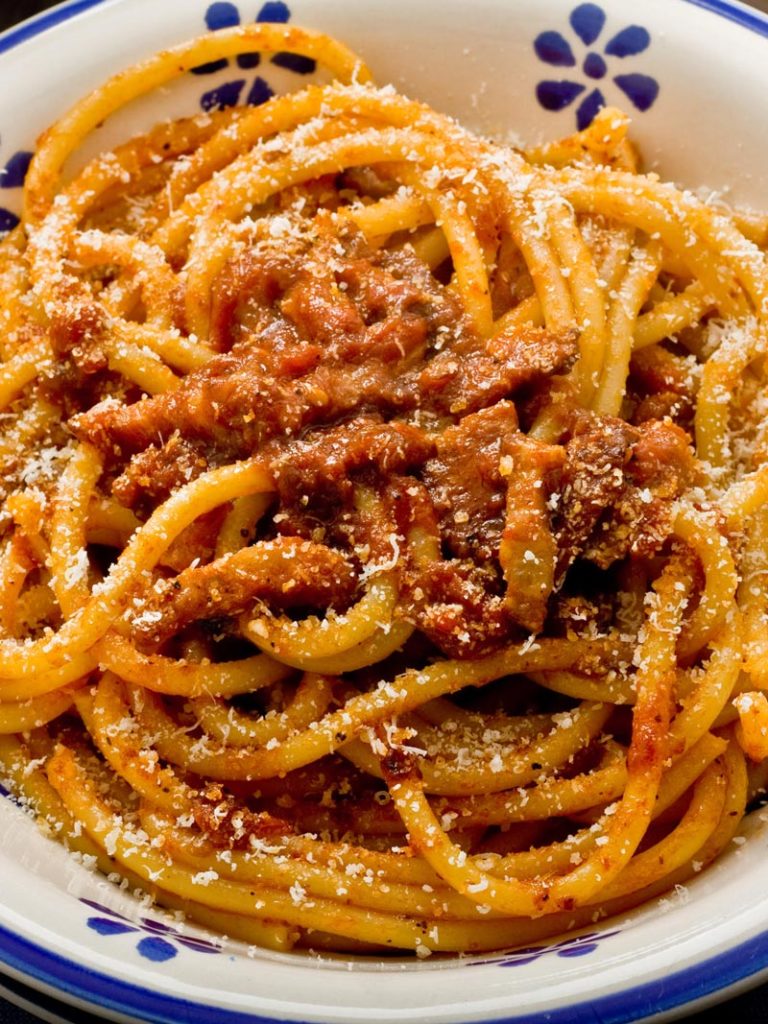A is for AMITRICIANA in our ItalianISSIMO Alphabet.

Pasta l’amatriciana, at our ISSIMO favourite Da Enzo al 29
If you’ve travelled to Rome, you’ve likely encountered the Eternal City’s four renowned pastas: carbonara, gricia, cacio e pepe and l’amatriciana. The only tomato-based star of the bunch is the amatriciana, a buonISSIMO creation that spotlights each of its few ingredients individually and combines them to create an outstandingly delicious primi. Guanciale (pork jowl), San Marzano tomatoes, pecorino cheese, pepper and chilli form the short list of ingredients but in the right hands – they sing together! Like every beloved Italian recipe however, the history of the dish is less straightforward.
Amatriciana does not, in fact, originate in Rome. The dish was popularized in the city’s restaurants and quickly became popular among both locals and the visitors that flocked to Italy’s capital. The recipe however hails from the town of Amatrice, a small but beautiful spot about two hours from the big city. But it would have taken a lot longer to travel that distance in the era amatriciana was created: the original recipe dates back almost 1000 years.

Pasta all’amatriciana with bucatini style pasta.
A millennium ago, the amatriciana originated in fields that bordered the Lazio town of Amatrice. Working shepherds would take cheese and pieces of guanciale into the pastures, cooking them over fire as they worked far distances from home. In an outdoor culinary feat, they also made fresh pasta for their dish, combining them all to make a delicious meal to sustain themselves as they worked.
But you may have noticed one of the ingredients is missing. Before the tomatoes became an integral part of the dish around the 1700s, the sugo, or sauce, was white, not red. The original amatriciana is now considered ‘amatriciana bianca’ and during the dish’s first era, the amatriciana more closely resembled the modern-day gricia pasta recipe. The history of the two classics are intertwined. In truth, the pasta alla gricia became the amatriciana over time.
The simple (but delicious!) dish was named for the nearby village of Grisciano and this is the version exists today – it is the gricia we know and love. But this is the story of the amatriciana. By the 18th Century, the tomatoes arrived, turning the buonISSIMO sauce red and resembling the modern dish.

The “guanciale”, or pork cheek, in preparation for the l’amatriciana sauce.
The Introduction of the Tomato
There are two theories of how the tomatoes became an integral part of the pasta. The first history points to a tragedy in 1529 when the town of Amatrice was burnt by Spanish invaders. The survivors fled to what was then the Kingdom of Naples. In Naples there was a bold new culinary experiment happening: tomatoes, which were previously thought to be far too acidic to eat, were now a common ingredient. And the residents of Amatrice observed this newfangled idea and added tomatoes to the gricia pasta tradition. Another theory points to an even more geographically roundabout reason the tomatoes became incorporated. Tomatoes and chilli are both native to the Americas and as travel, exploration and colonialism between the continents rose, these ingredients made their way into the sauce of the gricia, turning it into the amatriciana we love.
It was at this time the first known record of the recipe was recorded: at the turn of the 19th Century Roman chef Francesco Leonard wrote a cookbook entitled ‘L’Apicio Moderno’ and transcribed the popular primi in its pages. He was a cook at the court of Pope Pius VII and besides allowing us to trace the history of the pasta, it further created the connection between the amatriciana recipe and the city of Roma. Over the next centuries the dish tied Roma and Amatrice together, becoming more famous and popular.
So sacred are Italian recipes and food traditions that the amatriciana has been granted the classification of ‘prodotto agroalimentare tradizionale’: a traditional agro-alimentary product belonging to the province of Lazio. But that has not settled debates about the pasta! You will frequently find a buccatini pasta shape in the dish. This is believed to be the historically correct version and what the humble shepherds would have used in the fields, shaping the tubular pasta around wires or other circular objects and making them easy to transport before being cooked. However, using spaghetti in amatriciana has risen to prominence in the modern era – even the traditional festival in Amatrice uses it now!

The hills surrounding Amatrice, where pasta l’amatriciana finds its origins
A Roman Tradition: L’amatriciana with Da Enzo
If you consider that the pasta is created from just 6 ingredients, its long and evolving history is a marvel. What we know for certain that is on tables throughout Rome – and in the nearby town of Amatrice – we have all deliciously benefitted from centuries of culinary tradition! Discover all of ISSIMO’s recommendations for the region of Lazio.
As we said, in expert hands, the amatriciana ingredients sing! Travel with us to the quintessential Roman neighbourhood of Trastevere and one of Roma’s most celebrated restaurants: da Enzo al 29. The di Felice family has run the trattoria for four decades – they too have history with this pasta. Roberto di Felice shares his Amatriciana recipe with us today: